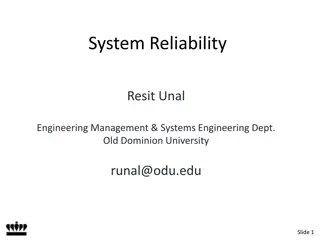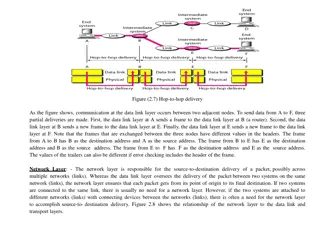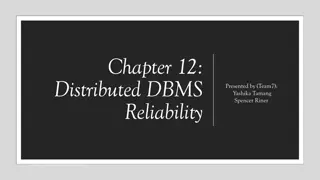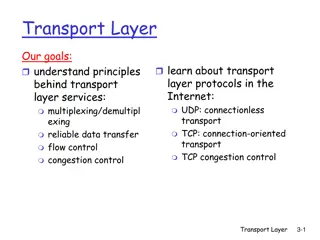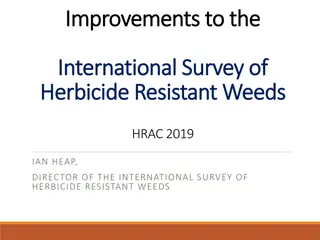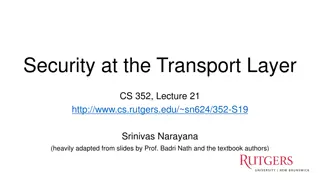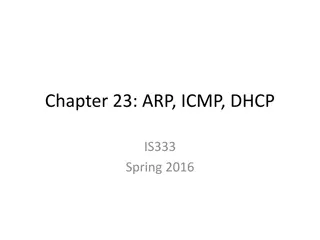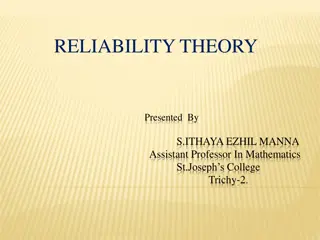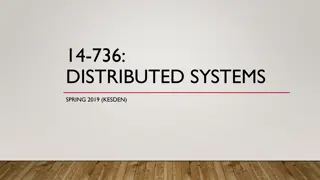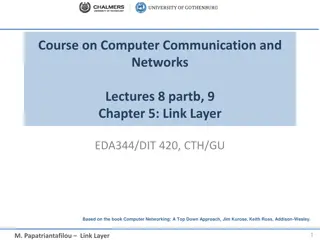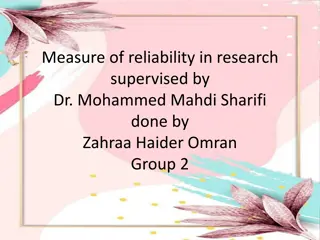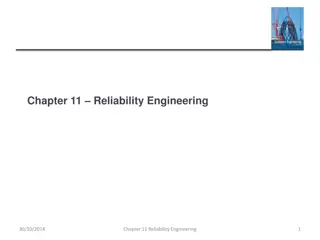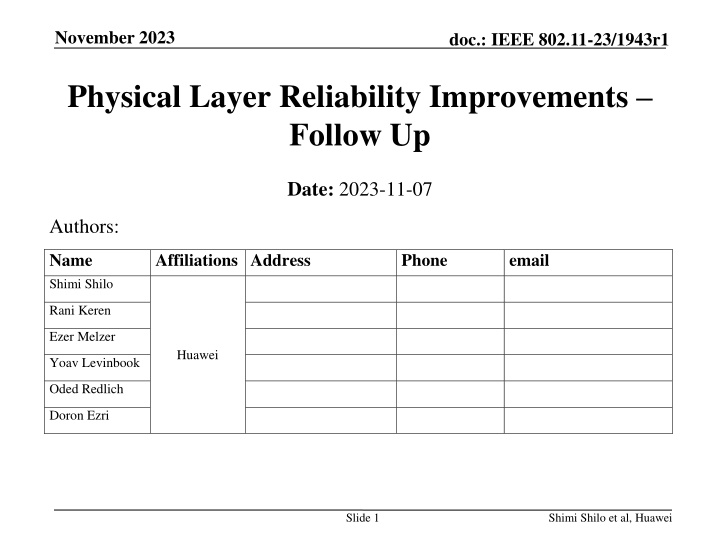
Improving Physical Layer Reliability in IEEE 802.11-23/1943r1: Insights and Approaches
Explore methods for enhancing reliability in IEEE 802.11-23/1943r1 with a focus on interference mitigation strategies. Addressing changing interference conditions and operational modes, this document discusses two key approaches: replicating data in the frequency domain and using known pilots for interference mitigation, each with its advantages and limitations. Discover how these techniques contribute to achieving Ultra-High Reliability (UHR) and efficient spectrum utilization.
Download Presentation

Please find below an Image/Link to download the presentation.
The content on the website is provided AS IS for your information and personal use only. It may not be sold, licensed, or shared on other websites without obtaining consent from the author. If you encounter any issues during the download, it is possible that the publisher has removed the file from their server.
You are allowed to download the files provided on this website for personal or commercial use, subject to the condition that they are used lawfully. All files are the property of their respective owners.
The content on the website is provided AS IS for your information and personal use only. It may not be sold, licensed, or shared on other websites without obtaining consent from the author.
E N D
Presentation Transcript
November 2023 doc.: IEEE 802.11-23/1943r1 Physical Layer Reliability Improvements Follow Up Date: 2023-11-07 Authors: Name Shimi Shilo Affiliations Address Phone email Rani Keren Ezer Melzer Huawei Yoav Levinbook Oded Redlich Doron Ezri Slide 1 Shimi Shilo et al, Huawei
November 2023 doc.: IEEE 802.11-23/1943r1 Introduction In [1] we discussed methods for improving the reliability in TGbn In particular, we suggested two different PHY related approaches for handling interference, using Interference Mitigation (IM - recap on those in the next two slides) approaches Improved reliability and more efficient use of the spectrum are important goals of UHR (Ultra-High Reliability) [2] In this contribution we address some questions that were raised during the presentation of [1] We present some additional results showing how these approaches deal with changing interference conditions, and discuss our view on the mode of operation Slide 2 Shimi Shilo et al, Huawei
November 2023 doc.: IEEE 802.11-23/1943r1 Recap: Approach #1 for Mitigating Interference Replicate data in frequency domain as shown in the figure below The receiver can identify if a portion of its spectrum is interfered, and based on this decide which subcarriers (or which replica) to combine (and how to combine) The choice of RU size to use and the replication order (number of replicas) can be opportunistic or based on knowledge at the transmitter side (e.g. on the interference characteristics) Advantages: Simple transmit scheme Significantly more robust to (narrowband) interference Disadvantages: Less applicable for wideband interference 26-tone 26-tone 4x replication to STA #1 26-tone 26-tone 26-tone 52-tone 2x replication to STA #2 52-tone Slide 3 Shimi Shilo et al, Huawei
November 2023 doc.: IEEE 802.11-23/1943r1 Recap: Approach #2 for Mitigating Interference Transmitting known pilots interlaced with the data will allow a (multi- antenna) receiver to track and mitigate potential interfering signals The receiver will apply an interference mitigation (receive beamforming) scheme Various algorithms may be employed Advantages: Can handle interference of any bandwidth Disadvantages: Need extra Rx antennas (beyond N_SS) to cancel the interference Interference Mitigation Pilot Data Slide 4 Shimi Shilo et al, Huawei
November 2023 doc.: IEEE 802.11-23/1943r1 Approach #1: Comparison with a lower MCS One question raised during the presentation of [1] was what would be the performance of a lower MCS in the presence of interference In the figure below we show a comparison between the performance in the presence of interference - of two schemes having (potentially) the same spectral efficiency MCS 2 without replication (1.5bps/Hz) MCS 4 with duplication (1.5bps/Hz) We assume a 242-tone data RU and a ~2 MHz interfering signal with SIR=0dB As can be seen, without replication even MCS 2 reaches an error floor whereas using replication yields a clear advantage Slide 5 Shimi Shilo et al, Huawei
November 2023 doc.: IEEE 802.11-23/1943r1 Approach #1: Comparison with a lower MCS (cont.) An alternative way to compare the results is to vary the interference power for a fixed SNR In the figure below we show a comparison between the performance in the presence of varying interference - of the same two schemes having (potentially) the same spectral efficiency We assume a 242-tone data RU and a ~2 MHz interfering signal with SNR=16dB As can be seen, there is a clear advantage to using a higher MCS with replication Slide 6 Shimi Shilo et al, Huawei
November 2023 doc.: IEEE 802.11-23/1943r1 Approach #2: Number of Required IM Pilots In [1] we showed simulation results both link-level & goodput which were based on an arbitrary number of IM pilots (~30% of the subcarriers) We were asked during the presentation of [1] whether so many IM pilots were needed In the figure below we show a comparison of the goodput of various values of IM pilots, when using a 106-tone RU As seen, a minimal number of IM pilots is needed (e.g. ~14% resources used for IM pilots is not enough) However, using around ~20% of the resources for IM pilots yields the best performance Slide 7 Shimi Shilo et al, Huawei
November 2023 doc.: IEEE 802.11-23/1943r1 Impact of Interference Rising and Falling What happens when the interference rises or falls in the middle of the PPDU? What effect does this have on the performance? In the figure below we compare the performance of approach #2 for the following 3 cases: Interference is constant for the entire PPDU Interference starts in the middle of the PPDU (within data portion) Interference starts at the beginning and ends in the middle of the PPDU As can be observed, this approach is not sensitive to where the interference begins or ends the gaps are quite small Meaning it is very robust Slide 8 Shimi Shilo et al, Huawei
November 2023 doc.: IEEE 802.11-23/1943r1 Method of Operation We view these PHY-based improved reliability approaches as tools that can be used in various scenarios where interference is likely to be dominant: home, enterprise, industrial, etc. Similar to MCS and NSS that can be adjusted to optimize the performance, this type of approach can be viewed as an additional Tx scheme dimension that may be exploited only when needed or when deemed important enough to invest resources in improving the reliability In other words, used only when necessary (or worth the effort) These approaches are not optimized for any particular scenario, but rather offer a general-purpose tool in the arsenal of Tx schemes For example, in case of long-term interference (constant across many PPDUs), one may choose to invest IM resources within only a subset of the PPDUs (so as to reduce overhead) and apply mitigation at the receiver throughout all received packets Slide 9 Shimi Shilo et al, Huawei
November 2023 doc.: IEEE 802.11-23/1943r1 Incorporating Interference Mitigation in TGbn for Reliability Improvement Increasing the reliability using Interference Mitigation is very important for several reasons: Interference is a real-life problem that is very dominant in WLAN As we ve shown, IM yields very significant performance improvements Applicable to every frequency band (2.4/5/6GHz) not limited to any particular band Why Interference Mitigation could be a key UHR feature It is directly related to Ultra High Reliability Can be used to increase reliability by increasing throughput and reducing latency & MPDU error rate in the presence of interference all covered within the scope of the project Interference mitigation is a PHY feature that provides benefits across the board all frequency bands, both UL and DL, all scenarios (where interference exists), and it improves not only the error rate of specific PPDUs but also long-term performance (incl. link adaptation) Doesn t increase peak throughput but improves performance in many practical scenarios Slide 10 Shimi Shilo et al, Huawei
November 2023 doc.: IEEE 802.11-23/1943r1 Conclusions In [1] we discussed how prevalent interference is in the WLAN bands, and how mitigating this interference (or the majority thereof) would lead to significantly better results, in particular lower latency We presented two approaches to mitigate the interference and showed, via simulation results, how we can improve the performance in the presence of interference In this contribution we addressed some questions that were raised during the presentation of [1] and presented some additional simulation results, both of which further justify these two approaches for improving the reliability We also discussed how we envision the system would operate using this type of improved reliability tool Slide 11 Shimi Shilo et al, Huawei
November 2023 doc.: IEEE 802.11-23/1943r1 References [1] 11-23-1490r0: Physical Layer Reliability Improvements (Shimi Shilo et al) [2] 11-23/0028r6: PAR Discussion (Laurent Cariou) Slide 12 Shimi Shilo et al, Huawei


